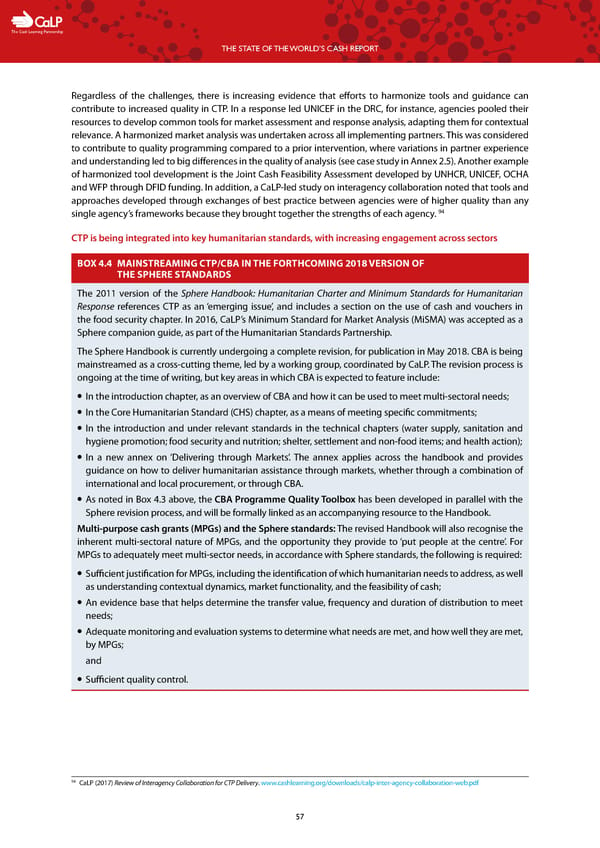C The Cash Learning Partnership THE STATE OF THE WORLD’S CASH REPORT Regardless of the challenges, there is increasing evidence that efforts to harmonize tools and guidance can contribute to increased quality in CTP. In a response led UNICEF in the DRC, for instance, agencies pooled their resources to develop common tools for market assessment and response analysis, adapting them for contextual relevance. A harmonized market analysis was undertaken across all implementing partners. This was considered to contribute to quality programming compared to a prior intervention, where variations in partner experience and understanding led to big differences in the quality of analysis (see case study in Annex 2.5). Another example of harmonized tool development is the Joint Cash Feasibility Assessment developed by UNHCR, UNICEF, OCHA and WFP through DFID funding. In addition, a CaLP-led study on interagency collaboration noted that tools and approaches developed through exchanges of best practice between agencies were of higher quality than any 94 single agency’s frameworks because they brought together the strengths of each agency. CTP is being integrated into key humanitarian standards, with increasing engagement across sectors BOX 4.4 MAINSTREAMING CTP/CBA IN THE FORTHCOMING 2018 VERSION OF THE SPHERE STANDARDS The 2011 version of the Sphere Handbook: Humanitarian Charter and Minimum Standards for Humanitarian Response references CTP as an ‘emerging issue’, and includes a section on the use of cash and vouchers in the food security chapter. In 2016, CaLP’s Minimum Standard for Market Analysis (MiSMA) was accepted as a Sphere companion guide, as part of the Humanitarian Standards Partnership. The Sphere Handbook is currently undergoing a complete revision, for publication in May 2018. CBA is being mainstreamed as a cross-cutting theme, led by a working group, coordinated by CaLP. The revision process is ongoing at the time of writing, but key areas in which CBA is expected to feature include: — In the introduction chapter, as an overview of CBA and how it can be used to meet multi-sectoral needs; — In the Core Humanitarian Standard (CHS) chapter, as a means of meeting specific commitments; — In the introduction and under relevant standards in the technical chapters (water supply, sanitation and hygiene promotion; food security and nutrition; shelter, settlement and non-food items; and health action); — In a new annex on ‘Delivering through Markets’. The annex applies across the handbook and provides guidance on how to deliver humanitarian assistance through markets, whether through a combination of international and local procurement, or through CBA. — As noted in Box 4.3 above, the CBA Programme Quality Toolbox has been developed in parallel with the Sphere revision process, and will be formally linked as an accompanying resource to the Handbook. Multi-purpose cash grants (MPGs) and the Sphere standards: The revised Handbook will also recognise the inherent multi-sectoral nature of MPGs, and the opportunity they provide to ‘put people at the centre’. For MPGs to adequately meet multi-sector needs, in accordance with Sphere standards, the following is required: — Sufficient justification for MPGs, including the identification of which humanitarian needs to address, as well as understanding contextual dynamics, market functionality, and the feasibility of cash; — An evidence base that helps determine the transfer value, frequency and duration of distribution to meet needs; — Adequate monitoring and evaluation systems to determine what needs are met, and how well they are met, by MPGs; and — Sufficient quality control. 94 CaLP (2017) Review of Interagency Collaboration for CTP Delivery. www.cashlearning.org/downloads/calp-inter-agency-collaboration-web.pdf 57
 The State of the World's Cash | Full Report Page 58 Page 60
The State of the World's Cash | Full Report Page 58 Page 60